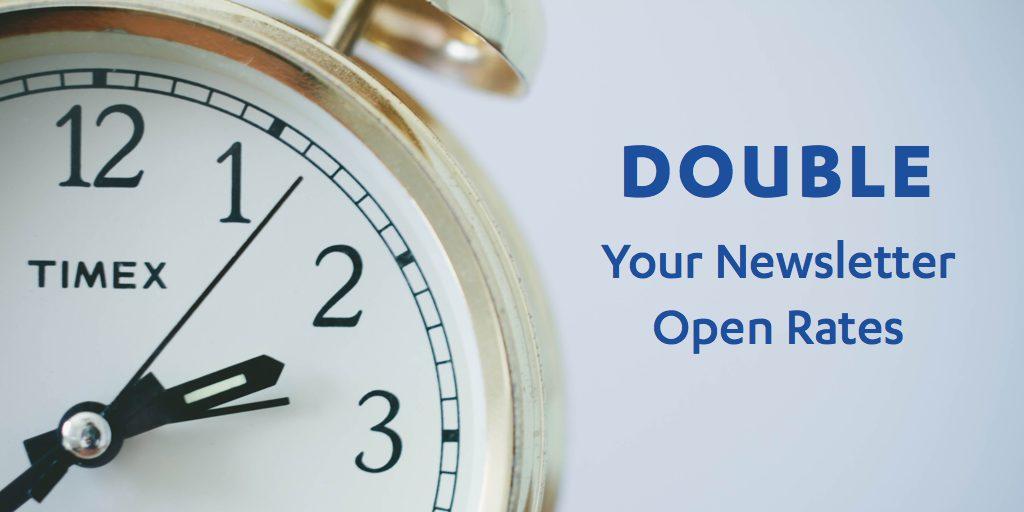April 2, 2015
5 Tips To Writing a Newsletter That Doubles Your Open Rates
Email marketing still delivers high ROI relative to other channels. Even though social media is portrayed as the best thing since sliced bread, email has nearly three times as many user accounts as Facebook and Twitter combined. Studies have shown that people spend 13 hours of their workweek in their email inbox. It’s where your leads and customers go often throughout the day, so being strategic about engaging with them there is important for your business. Whether you’re a solo real estate agent, boutique marketing agency, family run restaurant, or a venture backed tech startup, there’s a great place to start your email marketing efforts: an email newsletter. It’ll help you stay on people’s minds, establish credibility, and keep the relationship going. These five email newsletter best practices will put you on the right track as you get started.
1. Know thy customer
To entice your audience to sign up for your email newsletter, write down a sentence with the three main benefits a reader will get for subscribing. Here are four concrete examples:
Golden Boy Pizza – Sign up to get recipes, receive special promotions, and hear about events
Solo real estate agent – Sign up to get tips on how to approach the buying process, market trends, and new property listings in your area
Boutique marketing agency – Sign up to receive thoughts on branding, marketing whitepapers, and the latest work from our portfolio
Autopilot – Sign up to read about marketers who are killing it, remarkable customer journeys, and our favorite industry links
Place your benefits-driven sentence along with a lead capture form on your blog, website, and offline locations to start building your email list. With the foundation of your email newsletter value proposition in mind, designing your newsletter is up next.
2. Invest in a newsletter design that is worthy of your brand
Designing a template is part of the upfront work of starting an email newsletter. There are many examples of beautiful newsletters that can help jog the creative process. The template will evolve over time, but the majority of the work comes at the beginning. You have a couple of different options to create a newsletter design:
Option #1: Use plain text
Creating plain text emails is easy. Text-based emails can create a more personalized experience because they feel like an email you might write directly to a friend or colleague. The con is obviously they lack logos or branding. Here’s an example:  We used plain text in this example to alert blog subscribers to recently published content, and optimized it to get responses from readers because it’s written like it’s coming from a real person.
We used plain text in this example to alert blog subscribers to recently published content, and optimized it to get responses from readers because it’s written like it’s coming from a real person.
Option #2: Use an existing HTML template
Templates are great if you’re not a graphic designer. Check out these 600 free email templates and template builders to get a jumpstart. To look at another example, here’s a section from Lander’s email newsletter: 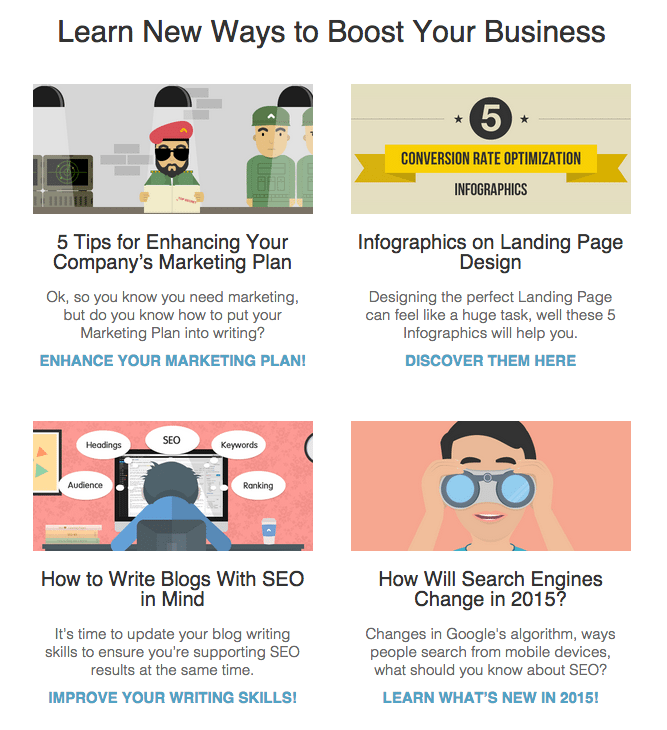 Lander went for a digest concept with blurbs and links to more content on their blog. The digest approach requires a large amount of content creation, but is a great option if you have the resources to make it happen.
Lander went for a digest concept with blurbs and links to more content on their blog. The digest approach requires a large amount of content creation, but is a great option if you have the resources to make it happen.
Option #3: Design from scratch
Work with your in-house design team to create a template or outsource it to a service like Fiverr. You can import your HTML email templates into a service like Autopilot to send them to your newsletter list. Here is Invision’s email template: 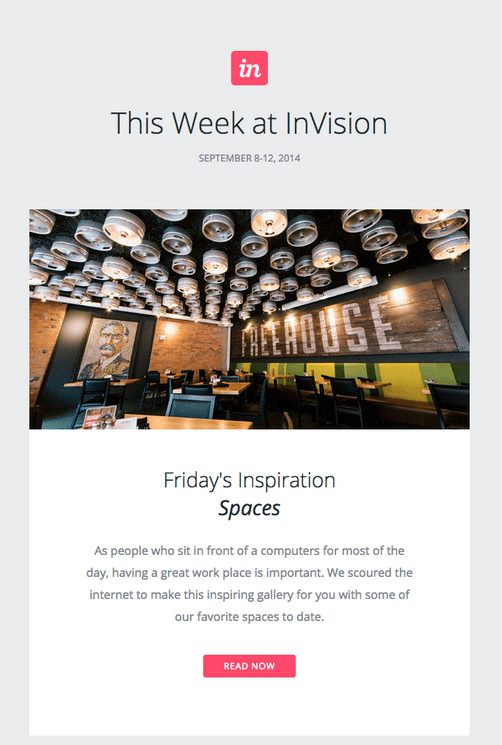 Invision went for a simple one-column approach with each article getting its own section and call-to-action to read more (see the full email). After your design is done, it’s time for content.
Invision went for a simple one-column approach with each article getting its own section and call-to-action to read more (see the full email). After your design is done, it’s time for content.
3. Re-purpose blog content and obsess over your subject line
A solid principle in how to approach your email newsletter content is to out-teach your competition. While everyone else is out selling (explicitly or implicitly), focus your attention on providing value. Awareness and conversion will follow. A good rule of thumb is to shoot for 95% teaching and 5% selling in your content.  To write effective content, keep the three types of email newsletter readers in mind:
To write effective content, keep the three types of email newsletter readers in mind:
Skimmers: People who will read the headlines, look at the pictures (and occasionally click), and do nothing else. Focus on writing headlines that give this group the main messages, even if that’s all they read
Sponges: People who read every word of your email. They’re after the details in addition to the main messages, and because they invest time, are more likely to love or hate particular blogs
Socialites: They’re hardcore because they click through all of your links and frequently share your content with their networks
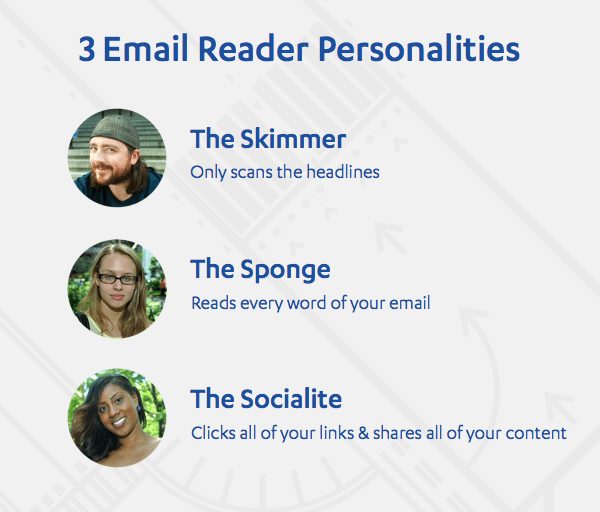
**So what about actual content creation? **
One approach is to write all-new content for each newsletter, tailored specifically to your readers. But who has time for that? An easier and more exciting approach is to use your newsletter as a digest of fresh blog and online content, as Lander does in the example above. The benefits of the digest newsletter is that you can repurpose hard-created content like industry best practices, customer stories, or infographics. Simultaneously you promote and drive traffic to your blog while providing more choice for your readers. When it’s time to buy, your audience will come to you because you’ve been staying in touch and providing value through teaching, not selling.
Obsess over your subject line
Writing effective subject lines that increase open rates by 203%, while flying under the spam radar, deserves a post of its own (keep your eyes peeled). In the meantime follow these simple guidelines:
Keep it short. Subject lines with 6 to 10 words generated the highest open rates
Use a tone and style that appeals to your target audience
Follow email personalization best practices by using the reader’s first name in the subject line and 2-3 times in the body text. Personalized emails deliver six times higher transaction rates
Avoid spam trigger words in the subject line like credit, discount, gimmick, obligation, or click here. See more spam trigger words
Summarize what’s inside. For example, Autopilot’s last newsletter subject line was “First name, high growth, dilemmas, and secrets inside”
Or you could go the route of saying “Weekly digest” or “Monthly newsletter” at the beginning of the subject line then writing what’s inside. The subject lines of Lander’s last newsletter was “March News: Email Marketing Tips, New Section & More!”
A/B test and keep notes from each email send - monitoring your KPIs (see below)
To learn more, check out the three key elements of irresistible email subject lines from Copyblogger.
4. Send newsletters at least monthly
Maintaining a regular email newsletter sending schedule is good for you and your readers. They’ll know what to expect from your end and you’ll be able to give yourself a deadline to meet. According to John Jantsch from Duct Tape Marketing, “You definitely want to establish a routine of expectation - say a weekly newsletter or roundup, but you want to be careful not to abuse your list with every good offer you can pound away at.”
"You definitely want to establish a routine of expectation"** - John Jantsch, Small Business Marketing Expert**
We recommend sending a newsletter at least once per month. Based on our own 2015 study involving 327 companies from 10+ industries, we learned that companies who send marketing communications to customers at least every 2-4 weeks generate twice as many leads as those who contact customers every 4-12 weeks. 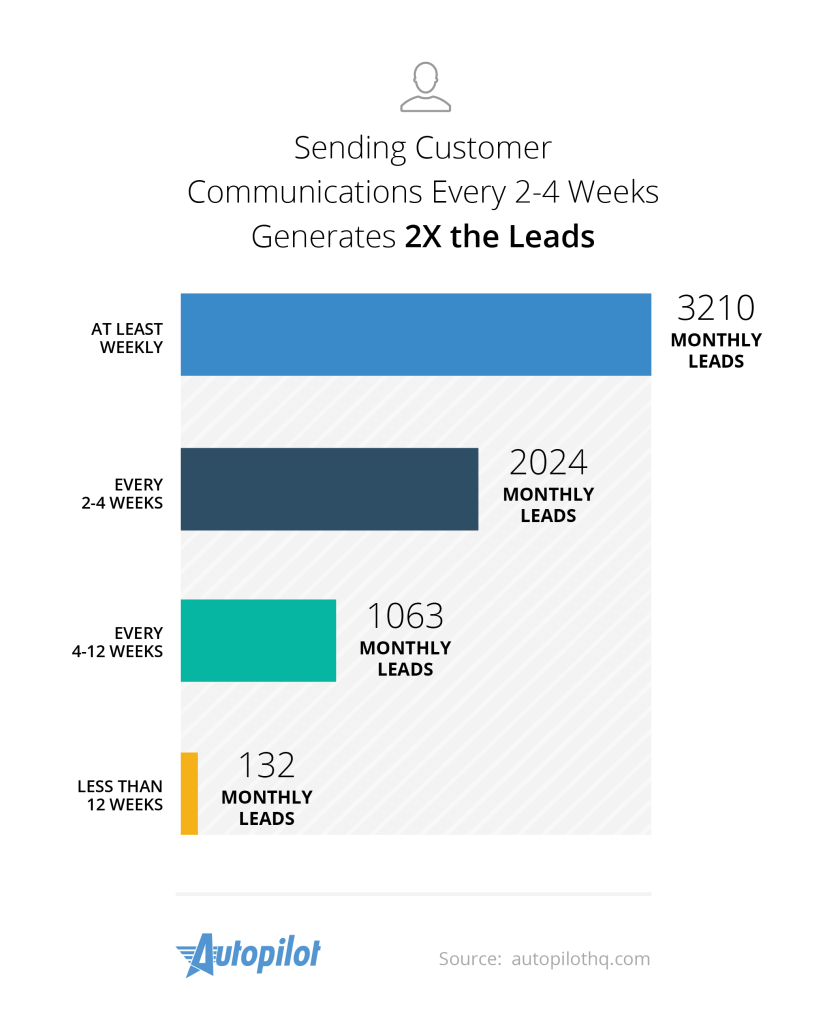
5. Test, iterate, and keep driving up your metrics
Most email newsletter software provides metrics and results. While rough industry benchmarks exist, newsletter performance varies by industry, customer demographic, geography, or business model - so make sure you carefully track the following:
Total number of contacts: Every member of your marketing team (and your execs) should know your marketing database size. Make sure you set quarterly/annual goals to grow these!
Open rate: Follow the above best practices, and you should achieve 10% - 20% newsletter open rates when sent to your entire marketing database (higher if you target specific segments)
Clickthrough rate: What percentage of subscribers who opened the email clicked a link or call-to-action in the email? Typically, 3% - 8% of general newsletter opens will click. But highly targeted messaging backed by a compelling offer can drive this up to 50%.
**Unsubscribe rate: **Once you have a groomed reader base, which means you’ve sent 4 or more monthly newsletters to the same list, then if you’re seeing unsubscribe rates that are more than 0.3% after each newsletter, then you need to revisit your targeting, content, or send frequency.
Leads attributed: How many leads or conversions are your emails producing? Add UTM tags to your email URLs to track conversions produced from emails using Google Analytics
Engagement & feedback: How are people responding to and engaged your newsletters? To set this up logistically, request a reply to a support email address like support@yourcompanyname.com or your work email address. Embed a link to a SurveyMonkey survey for feedback. Also, track shares and impressions of the social, blog, whitepaper, or website content that you link to before and after your newsletter send, to understand nuances like how time of day or geography impacts your send and content strategies.
That’s the end of our best newsletter practices. Now for a special bonus: how to effortlessly double your open rates.
How to double your newsletter open rates
So you’ve crafted a terrific newsletter with curated content, targeted your send, A/B tested your subject line, linked to top performing blog content, included a compelling promo offer…and still 80-85% of your list doesn’t even open the email. Seems like a waste, right? We think so. Turns out many of these subscribers actually do want to hear from you, but somehow missed your first send - they were busy or traveling, didn’t have time to open that day, etc. etc. Solution: re-send another copy of your email newsletter 48 hours later to those who did not open the first email, with a small modification to the subject line (e.g. “Reminder:



